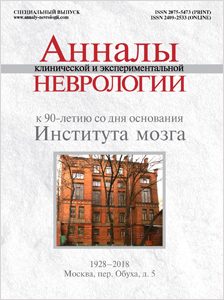Методы иммуногистохимии и компьютерной морфометрии – перспективные инструменты в изучении патогенетических закономерностей нейродегенеративных процессов
- Авторы: Худоерков Р.М.1, Сальков В.Н.1, Воронков Д.Н.1
-
Учреждения:
- ФГБНУ «Научный центр неврологии»
- Выпуск: Том 12, № 5S (2018)
- Страницы: 55-59
- Раздел: Обзоры
- Дата подачи: 26.12.2018
- Дата публикации: 26.12.2018
- URL: https://annaly-nevrologii.com/journal/pathID/article/view/562
- DOI: https://doi.org/10.25692/ACEN.2018.5.7
- ID: 562
Цитировать
Полный текст
Аннотация
Современные методы иммуногистохимии и компьютерной морфометрии дают богатые возможности для изучения патогенетических закономерностей процесса нейродегенерации, происходящего при физиологическом старении мужчин и женщин, а также при моделировании болезней Паркинсона и Гентингтона у экспериментальных животных. Трехмерная реконструкция компактной части черной субстанции мозга человека и мозга крысы выявила как общие черты в их организации (гетерогенность структур), так и различия в количественных морфохимических показателях, обусловливающих их видоспецифические характеристики. При моделировании болезни Гентингтона с помощью нейротоксина 3-нитропропионовой кислоты (3-НПК) была показана не только гибель нейронов стриатума и снижение его дофаминергической иннервации, но и повреждение астроцитов со снижением в них экспрессии глутаминсинтетазы, что может увеличивать содержание внеклеточного глутамата. Последний, наряду с прямым блокирующим действием 3-НПК на сукцинатдегидрогеназу, является одним из факторов формирования нейродегенеративных изменений в стриатуме. При моделировании болезни Паркинсона была показана важная роль нейроглии в нейродегенеративном процессе: выявлено, что активированная астроглия выполняет не только деструктивную, но и нейропротекторную функцию, что может служить основой для разработки соответствующих методов фармакологической коррекции, направленных на регуляцию функций глиальных клеток.
Ключевые слова
Об авторах
Рудольф Михайлович Худоерков
ФГБНУ «Научный центр неврологии»
Автор, ответственный за переписку.
Email: rolfbrain@yandex.ru
Россия, Москва
Владимир Николаевич Сальков
ФГБНУ «Научный центр неврологии»
Email: rolfbrain@yandex.ru
Россия, Москва
Дмитрий Николаевич Воронков
ФГБНУ «Научный центр неврологии»
Email: rolfbrain@yandex.ru
Россия, Москва
Список литературы
- Иллариошкин С.Н. Современные представления об этиологии болезни Паркинсона. Неврологический журнал 2015; 4: 4–13.
- Khudoerkov R.M., Voronkov D.N. Quantitative assessment of neurons and neuroglia with computer morphometry. Bull Exp Biol Med 2010; 149: 100–103. PMID: 21113470.
- Blesa J., Przedborski S. Parkinson’s disease: animal models and dopaminergic cell vulnerability. Front Neuroanat 2014; 8: 1–12. DOI: 10.3389/ fnana.2014.00155. PMID: 25565980.
- Brichta L., Greengard P. Molecular determinants of selective dopaminergic vulnerability in Parkinson’s disease: an update. Front Neuroanat 2014; 8: 152. doi: 10.3389/fnana.2014.00152. PMID: 25565977.
- Damier P., Hirsch E.С., Agid Y., Graybiel A.M. The substantia nigra of the human brain. I. Nigrosomes and nigral matrix, a compartmental organization based on calbindin D28k immunogistochemistry. Brain 1999; 122: 1421–1436. DOI: 1093/brain/122.8.1421. PMID: 10430829.
- Bellinger F.P., Bellinger M.T., Seale L.A. et al. Glutathione peroxidase 4 is associated with neuromelanin in substantia nigra and dystrophic axons in putamen of Parkinson’s brain. Mol Neurodeg 2011; 6: 1–8. doi: 10.1186/1750-1326-6-8. PMID: 21255396.
- Brouillet, E., Jacquard, C., Bizat, N., Blum, D., 3-Nitropropionic acid: a mitochondrial toxin to uncover physiopathological mechanisms underlying striatal degeneration in Huntington’s disease. J Neurochem 2005; 95(6): 1521.
- Jellinger K.A. Neuropathobiology of non-motor symptoms in Parkinson disease. J Neural Transm 2015; 122: 1429–1440. doi: 10.1007/s00702-015-1405-5. PMID: 25976432.
- Jyothi H.J., Vidyadhara D.J., Mahadevan A. et al. Aging causes morphological alterations in astrocytes and microglia in human substantia nigra pars compacta. Neurobiol Aging 2015; 36: 3321–3333. DOI: 0.1016/j.neurobiolaging. 2015.08.024. PMID: 26433682.
- Kordower J.H., Olanow C.W., Dodiya H.B. et al. Disease duration and the integrity of the nigrostriatal system in Parkinson’s disease. Brain 2013; 136: 2419–2431. doi: 10.1093/brain/awt192. PMID: 23884810.
- Rudow G., O’Brien R., Savonenko A.V.et al. Morphometry of the human substantia nigra in ageing and Parkinson’s disease. Acta Neuropathol 2008; 115: 461–470. doi: 10.1007/s00401-008-0352-8. PMID: 18297291.
- Zucca F.A., Giaveri G., Gallorini M. et al. The neuromelanin of human substantia nigra: physiological and pathogenic aspects. Pigment Cell Res 2004; 17: 610–617. doi: 10.1111/j.1600-0749.2004.00201.x. PMID: 15541018.
Дополнительные файлы








